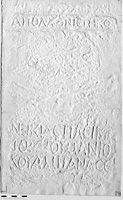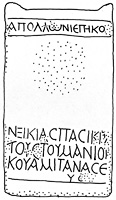 MAMA XI 365 (Komitanassos)
MAMA XI 365 (Komitanassos) 
Votive bomos of Neikias to Apollo
- Type of monument:
- Votive bomos.
- Location:
- Ortakuyu (Komitanassos): in a house.
- Description:
- Grey marble bomos. On front face, line 1 of the inscription between rough guide-lines at top; below, defaced relief; lines 2-5 at bottom. On the right-hand face, in relief, mounted rider, holding spear in left hand, double-axe (?) in right hand; below, a figure in a long robe advancing left, with spear in left hand and patera in right hand.
- Dimensions:
- Ht. 0.39; W. 0.215; Th. 0.13; letters 0.012-0.030.
- Record:
- Squeeze; line drawing; MB notebook copy (1956/191).
- Publication:
- Ballance 1958: 227-8; (BE 1959, 434; SEG 17, 544); I.Konya 43.
- Date:
- Roman imperial period.
Ἀπόλλωνι ἐπηκό[ῳ]
defaced relief
Νεικίας Πασικρ̣ά̣-
τους τοῦ Μανίου̣
Κουαμιτανασε-
5ύς
To Apollo who listens, Neikias son of Pasikrates son of Manius, of Kouamitanasos.





For the names Pasikrates and Manius, see MAMA XI 294 (1957/47: Tatlıkuyu/Akbaş), in which the inhabitants of a village on the territory of Ikonion honour a benefactor by the name of Manius son of Pasikrates, presumably a relative of the man named in this inscription.
Three votive bomoi dedicated to Apollo, all found together at an unnamed village near Aksaray, are now in the Nevşehir Museum (French 2007: 82-4, nos. 19-21). No. 19 describes the deity as [Φοί]βῳ Ἀπόλλ̣[ωνι] ἐπηκόῳ, and no. 20 was dedicated by a certain Αὐρ. Νικάνωρ Ἱέρακος Κομιτανασσεύς. French thus reasonably suggests that these three bomoi derive from the same sanctuary of Apollo as the inscription copied by Ballance, and that the ‘village near Aksaray’ is likely to have been Ortakuyu.
On the right-hand side of the bomos copied by Ballance at Ortakuyu (not, as stated by Ballance 1958: 227, the left-hand side) a mounted horseman with spear and double-axe was depicted in relief (not noted by McLean, I.Konya 43). A further votive bomos to Apollo, said to derive from Setik Yayla, c. 27km NNE of Ortakuyu, near Eskil in the steppe south of Lake Tatta, was published by French 2007: 88, no. 27. This bomos was set up by a certain Σιλβανὸς Ἀθηνέου, and depicts Apollo in relief as a rider-god wielding a double-axe. It seems very likely that this bomos also ultimately derives from the same sanctuary at Ortakuyu.
The bomos from Setik Yayla suggests a possible reattribution for I.Konya 26, a small bomos dedicated to Ἀπόλλωνει ἐπηκόῳ by Λούκις Σιλβανοῦ, with a relief depicting Apollo as a rider-god. The editor of I.Konya records the provenance of this monument as Meydanlı, between Toriaion and Laodikeia in Phrygia Paroreios. However, given the patronym of the dedicator (Silvanus, as in French 2007: 88, no. 27) and the manner of depicting Apollo, it seems very likely that this monument too should be attributed to the Ortakuyu sanctuary. It is, finally, conceivable that MAMA XI 314 (1956/175: a dedication to Ἀπόλλωνει θεῷ ἐπηκόῳ at Giymir) has travelled from Ortakuyu to Giymir. For depictions of Apollo as a rider-god in central Asia Minor, see further Delemen 1999: 43-57, 167-75, with the Pisidian addenda of I.BurdurMus nos. 7, 11, 19, with pp. 255-74. Apollo is also depicted as a rider-god in I.Konya 27 (unknown provenance); cf. perhaps MAMA XI 257 (1957/87: Ladık).
On the term ἐπήκοος, see Versnel 1981: 34-7, and cf. MAMA XI 145 (1955/39: Karasandıklı). For a dedication to Asklepios and Hygeia ἐπήκοοι from Ortakuyu, see MAMA XI 366 (1956/192). At neighbouring Savatra, dedications are known to Ἄρῃ ἐπηκόῳ (Robert, Hellenica X, 72-8; SEG 15, 817), Ἄρηι καὶ Ἀρείαις [θε]οῖς ἐπηκόοις (SEG VI 455) and anonymous [ἐπη]κόοις θεοῖς (MAMA VIII 227); see Robert, Hellenica XIII, 43-4.
The tabula Peutingeriana marks a road-station by the name of Comitanasso, twenty miles east of Perta on the ‘North Lykaonian Road’ (Ballance 1958: 224-8; TIB Galatien 100). The ethnic Κουαμιτανασεύς in this inscription clearly refers to the same site (Zgusta 1984: 297 §598); the votive bomos published by French 2007: 82-3, no. 20, gives the ethnic in the form Κομιτανασσεύς. Ballance 1958: 228 plausibly suggested that Komitanassos ought to be situated at Ortakuyu itself (accepted by TIB Galatien 153, s.v. Comitanasso); the modern village is built among the remains of a substantial ancient settlement, and lies some 18.5 miles east of Giymir (the site of Perta), which corresponds well with the ‘twenty miles’ of the Peutinger Table.